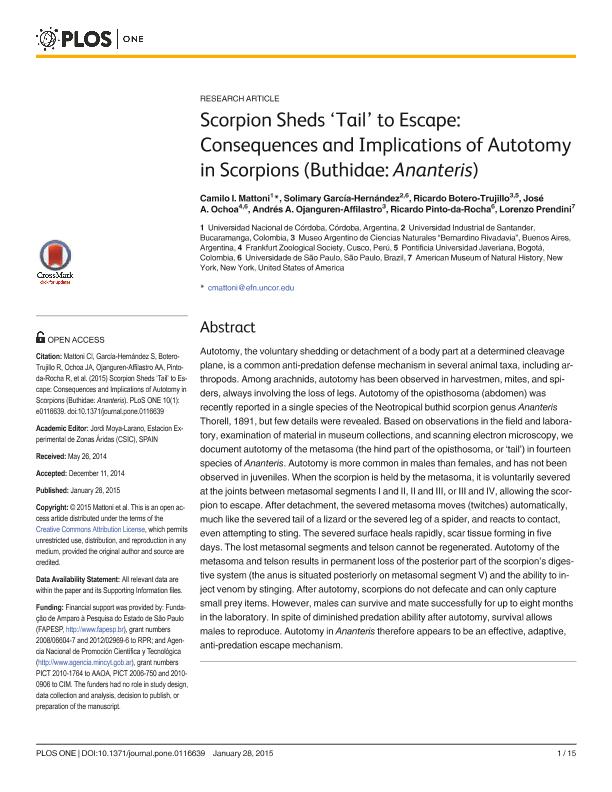Artículo
Scorpion sheds 'tail' to escape: consequences and implications of autotomy in scorpions (Buthidae: Ananteris)
Mattoni, Camilo Ivan ; García Hernández, Solimary; Botero Trujillo, Ricardo
; García Hernández, Solimary; Botero Trujillo, Ricardo ; Ochoa, José A.; Ojanguren Affilastro, Andres Alejandro
; Ochoa, José A.; Ojanguren Affilastro, Andres Alejandro ; Pinto da rocha, Ricardo; Prendini, Lorenzo
; Pinto da rocha, Ricardo; Prendini, Lorenzo
 ; García Hernández, Solimary; Botero Trujillo, Ricardo
; García Hernández, Solimary; Botero Trujillo, Ricardo ; Ochoa, José A.; Ojanguren Affilastro, Andres Alejandro
; Ochoa, José A.; Ojanguren Affilastro, Andres Alejandro ; Pinto da rocha, Ricardo; Prendini, Lorenzo
; Pinto da rocha, Ricardo; Prendini, Lorenzo
Fecha de publicación:
01/2015
Editorial:
Public Library Of Science
Revista:
Plos One
ISSN:
1932-6203
Idioma:
Inglés
Tipo de recurso:
Artículo publicado
Clasificación temática:
Resumen
Autotomy, the voluntary shedding or detachment of a body part at a determined cleavage plane, is a common anti-predation defense mechanism in several animal taxa, including arthropods. Among arachnids, autotomy has been observed in harvestmen, mites, and spiders, always involving the loss of legs. Autotomy of the opisthosoma (abdomen) was recently reported in a single species of the Neotropical buthid scorpion genus Ananteris Thorell, 1891, but few details were revealed. Based on observations in the field and laboratory, examination of material in museum collections, and scanning electron microscopy, we document autotomy of the metasoma (the hind part of the opisthosoma, or ?tail?) in fourteen species of Ananteris. Autotomy is more common in males than females, and has not been observed in juveniles. When the scorpion is held by the metasoma, it is voluntarily severed at the joints between metasomal segments I and II, II and III, or III and IV, allowing the scorpion to escape. After detachment, the severed metasoma moves (twitches) automatically, much like the severed tail of a lizard or the severed leg of a spider, and reacts to contact, even attempting to sting. The severed surface heals rapidly, scar tissue forming in five days. The lost metasomal segments and telson cannot be regenerated. Autotomy of the metasoma and telson results in permanent loss of the posterior part of the scorpion?s digestive system (the anus is situated posteriorly on metasomal segment V) and the ability to inject venom by stinging. After autotomy, scorpions do not defecate and can only capture small prey items. However, males can survive and mate successfully for up to eight months in the laboratory. In spite of diminished predation ability after autotomy, survival allows males to reproduce. Autotomy in Ananteris therefore appears to be an effective, adaptive, anti-predation escape mechanism.
Palabras clave:
Scorpiones
,
Ananteris
,
Autotomy
Archivos asociados
Licencia
Identificadores
Colecciones
Articulos(IDEA)
Articulos de INSTITUTO DE DIVERSIDAD Y ECOLOGIA ANIMAL
Articulos de INSTITUTO DE DIVERSIDAD Y ECOLOGIA ANIMAL
Citación
Mattoni, Camilo Ivan; García Hernández, Solimary; Botero Trujillo, Ricardo; Ochoa, José A.; Ojanguren Affilastro, Andres Alejandro; et al.; Scorpion sheds 'tail' to escape: consequences and implications of autotomy in scorpions (Buthidae: Ananteris); Public Library Of Science; Plos One; 10; 1; 1-2015; 1-15
Compartir
Altmétricas



